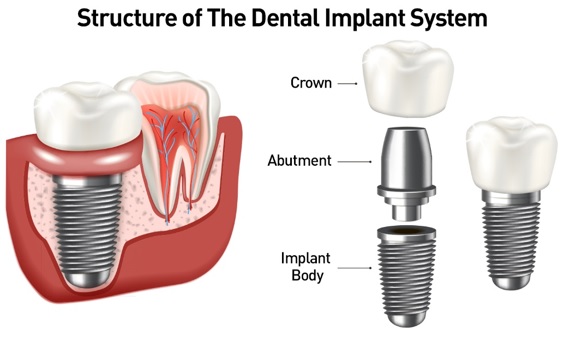Getting The Dental Implants To Work
Getting The Dental Implants To Work
Blog Article
Dental Implants Things To Know Before You Buy
Table of ContentsSome Known Questions About Dental Implants.What Does Dental Implants Mean?See This Report about Dental ImplantsThings about Dental Implants
are clinical gadgets operatively implanted into the jaw to bring back a person's ability to chew or their appearance. They give support for man-made (fake) teeth, such as crowns, bridges, or dentures. When a tooth is lost because of injury or condition, an individual can experience difficulties such as quick bone loss, defective speech, or changes to chewing patterns that lead to discomfort.
Framework of The Dental Implant System choosing dental implants, talk to your oral supplier about the potential advantages and dangers, and whether you are a prospect for the treatment. Things to think about: Your general health is an essential factor in figuring out whether you are an excellent candidate for oral implants, how long it will certainly require to recover, and for how long the dental implant might remain in place.
Cigarette smoking may affect the healing process and reduce the long-term success of the implant. The recovery process for the dental implant body may take several months or longer, throughout which time you typically have a temporary joint in location of the tooth. the dental implant treatment: Meticulously adhere to the oral health instructions given to you by your dental supplier.
Some Known Details About Dental Implants
Implant failure can result in the demand for an additional surgical treatment to deal with or change the dental implant system. Recovers the capacity to eat Brings back cosmetic appearance Assists keep the jawbone from diminishing because of bone loss Protects the wellness of the bordering bone and gum tissues Helps keep surrounding (neighboring) teeth steady Enhances quality of life Damage to bordering all-natural teeth during implant placement Injury to the surrounding tissues throughout surgical procedure, such as sinus opening Injury throughout surgical procedure (for instance, crack of bordering jawbone) Poor feature, such as feeling like the teeth do not attack together typically A sensation that the tooth is loosened or turning in place resulting from a joint screw loosening up Implant body failure (looseness of the implant body) due to systemic infection, which may be more likely in clients with unrestrained diabetes mellitus because of neighborhood infection in bone and gums sustaining the implant body as a result of delayed healing, which might be more likely in people that smoke Trouble cleansing the gums around the dental implant, leading to inadequate oral health Unattended periodontal condition Post-surgical tingling due to nerve impingement or damages Constantly inform health treatment providers and imaging professionals that you have dental implants prior to any type of magnetic resonance imaging (MRI) or x-ray treatments.
FDA is not aware of any type of adverse events reported for MRI or x-ray treatments with dental implants. Dental implants systems are generally constructed from materials that comply with global consensus requirements of the International Company for Standardization (ISO) or ASTM International. These requirements have information of what makes a safe product.
Various other materials such as gold alloys, cobalt-based alloys, titanium alloys, right here or ceramic products are occasionally used. The safety and security accounts of these materials are well-known. Dental dental implant systems are reviewed according to international consensus requirements. Biocompatibility testing, to reveal that physical contact More Info with the tool does not cause complications like inflammation or sensitive response, is part of the assessment that aids guarantee the products in the oral implant system are secure and do not trigger adverse results when implanted in people.

The smart Trick of Dental Implants That Nobody is Talking About
Some people are not eligible for dental implant surgical procedure. It is for dental doctors to operate people with: severe illnessuncontrollable metabolic diseasebone or soft cells illness or infectionIf these issues are resolved, a person can have the surgical procedure. Dental Implants. In, dental doctors refrain from operating individuals with: If individuals with any of the above undergo oral implant surgical procedure, there is a greater danger of the implant failing
Some people have a jawbone irregularity that avoids enough bone for an implant from developing. In such instances, a cosmetic surgeon might need Your Domain Name to do a ridge modification. This involves raising the gum tissue to expose the location of flawed bone. The surgeon will certainly after that utilize a bone or bone substitute to fix and develop the location.
Oral implant surgical procedure is a customized process. Give you time to heal. Affix the message and last crown, bridge or denture.
Next, your cosmetic surgeon will thoroughly position the dental implant right into your jaw. Lastly, your surgeon will certainly rearrange your periodontals and shut the incision with stitches. If your dental implant is near the front of your mouth, your dental expert will certainly make a short-term tooth for you to use till you recover. This way, you won't have a space in your smile while you recoup.
Unknown Facts About Dental Implants
Your copyright can inform you what to anticipate in your circumstance. During the recovery stage, your jawbone must fuse to the dental implant. This procedure, called osseointegration, is critical for security and lasting success. This process can take anywhere from three to 9 months. In many cases, it might take much longer.
When your implant heals, your dental expert can attach the joint (little connector article) and your last repair (crown, bridge or denture). This generally takes regarding one hour to complete and might need a 2nd minor surgery. You should not feel any kind of discomfort during your dental implant treatment since your copyright will certainly make use of drug to numb your gums.
Report this page